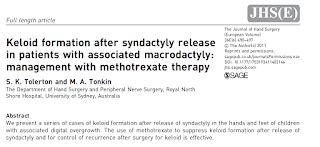Macrodactyly is very rare, even at centers such as ours that evaluate and treat many kids with birth anomalies of the upper extremity. Macrodactyly is a difficult condition to research as there is so much variability in presentation- fingers may be dramatically large, moderately large, or only slightly larger than the expected finger size. Treatment varies depending on the age of the child and the severity of the macrodactyly. This manuscript nicely summarizes treatment strategies.
 |
| Excellent review on macrodactyly treatment |
Keloid is the prominent thickening of scar after trauma or a surgical incision. It is more often seen in dark skinned patients and is common on the torso. If a patient demonstrates keloid formation at the site of one scar/ surgery, the patient is more likely to demonstrate keloid formation at the next surgery site. Treatment of macrodactyly carries a risk of keloid formation. Syndactyly reconstruction in patients with enlarged digits likewise carries a risk of keloid formation. The medication Methotrexate has been suggested as a means to treat keloid formation, typically at the time of a revision surgery. Two manuscripts have reviewed this issue and the use of methotrexate:
Here are two examples of keloid formation after treatment of syndactyly patients. In the first, there was a clear, dramatic macrodactyly of the middle finger with syndactyly to an unaffected ring finger. The family requested reconstruction of the syndactyly. Scarring is prominent.
 |
| Macrodactyly and syndactyly |
 |
| Thickened scars on both fingers after syndactyly reconstruction and debulking of macrodactyly. |
 |
 |
| Thickened scars on both fingers after syndactyly reconstruction and debulking of macrodactyly. |
|
In the second case, the digit enlargement is much more subtle. But there is likely a degree of digit enlargement associated with prominent scarring after syndactyly reconstruction.
 |
| Syndactyly preoperative. |
 |
| Prominent scarring after syndactyly reconstruction |
 |
| A more detailed view of scarring after syndactyly reconstruction. |
Revision treatment of both of these patients is an option. At the time of revision surgery, methotrexate would be considered and a lengthy discussion with the family will be important regarding the risks and benefits of this medication.









